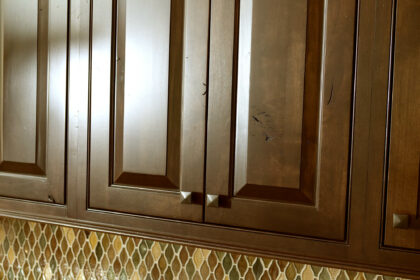Your Cabinets, Our Specialty
Specialty woods take your cabinet personalization to the next level. Their unique patterns and variations are unlike standard wood types, and are made even more special with Showplace styles and finishes.
Rustic Alder

Why choose rustic alder cabinets?
Rustic alder is a straight, softer wood that holds up to humid climates better than some hardwoods. Though prized for its grain pattern and reddish undertones, rustic alder takes up paint and stains well. This domestic hardwood, also known as red alder, grows mostly in the Pacific Northwest and is a green-approved building material.
As the softest wood we offer, alder needs extra care to avoid denting and marring. Some knots may have holes that can pass completely through the cabinet door, but larger holes remain unfilled to achieve the desired rustic look. Highlight this wood’s natural character with a lighter finish, or give it a more urban, industrial look with a darker finish.
Rustic alder is also available in our full range of painted finishes.

Rustic Alder
Create an environment of authentic warmth and homey charm with rustic alder. Featuring cherry-like grain, rustic alder displays visible knots, mineral, and color variation in the door frames and solid center panels.
See Available Stains
















View homes with rustic alder cabinets
Rustic Hickory
Why choose rustic hickory cabinets?
Hickory is an extremely strong wood with a bold, energetic look. It features color changes, a smooth feel, and strong, flowing grain patterns. Variations between heartwood and sapwood causes a color that can range from blonde to reddish-brown to dark brown.
Rustic hickory is known to contain knots, swirled grain, mineral streaks, and other marks. Enhance its rugged appearance and coarse texture with a light stain, or tone down the color variation with a medium-toned stain. Glazing is often added to enhance its aged look.

Rustic Hickory
The outgoing extrovert of the hardwood family, dense, heavy hickory displays vibrant grain patterns and wide variation in color and texture, as well as visible knots and other rustic features. Lighter stains make this feature most evident, while darker stains tend to mute it.
See Available Stains

















View homes with rustic hickory cabinets
Quartersawn White Oak

Why choose quartersawn white oak cabinets?
Quartersawn White Oak requires a more difficult and more costly quartersawing method to yield material with a distinctive grain pattern, as well as unique flecks and rays, that are only available through this technique. With its superior stability, this wood is very straight and has a low tendency to cup or warp. The quartersawing method is most often used for mission-style furniture and cabinetry from the arts and crafts period.
Since oak can darken with age, consider modernizing it by choosing a light shade or wash.

Quartersawn White Oak
Showplace uses genuine quartersawn white oak for face frames, end panels, and coordinating elements like moldings on all quartersawn cabinetry orders. Other cabinetry brands may include cheaper, non-quartersawn components with quartersawn doors.
See Available Stains
















View homes with quartersawn white oak cabinets
Walnut
Why choose walnut cabinets?
Walnut is a luxurious medium density hardwood known for its strength and durability. Distinguished as an authentic premium species, walnut is defined by natural characteristics and rich color that is treasured for its unique visual appeal.
The heartwood color of walnut can range from tan to dark brown to purplish-gray while the sapwood color can range from creamy white to blonde. Walnut grain can vary from straight to highly-figured and will have occasional near-black mineral streaks, pin knots and filled knots. These natural characteristics, along with unique color variability and grain patterns, add to walnut's natural beauty and distinguish it as a prized furniture-grade species.

Walnut
Walnut will demonstrate some color variability between heartwood and sapwood and its grain can vary from straight to highly configured. Although walnut is steamed to help blend the heartwood/sapwood transition, a darker stain is recommended when less color variation is desired.
See Available Stains





Bear in mind that variability is one of wood's finest natural qualities, and actual finishes will differ. Computer displays also add their own interpretation to colors. Please make your finish selection based on actual finished samples at your Showplace dealer.
